What We’re Reading: March 23rd
Review. Autophagy: The master of bulk and selective recycling
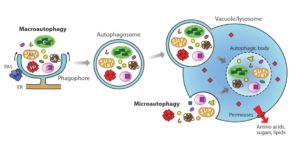 A functioning cell depends upon the appropriate production of proteins and macromolecules. The other end of the process, degradation and removal, is just as critical and just as selective. Marshall and Vierstra review autophagy (“self-eating”) in plants, connecting early work in yeast to genetic, metabolomic and physiological studies in Arabidopsis and other plant species. This review surveys the diverse forms of autophagy, their regulation, and their involvement in nutrient and energy homeostasis and defense. (Summary by Mary Williams) Annu. Rev. Plant Biol. 10.1146/annurev-arplant-042817-040606
A functioning cell depends upon the appropriate production of proteins and macromolecules. The other end of the process, degradation and removal, is just as critical and just as selective. Marshall and Vierstra review autophagy (“self-eating”) in plants, connecting early work in yeast to genetic, metabolomic and physiological studies in Arabidopsis and other plant species. This review surveys the diverse forms of autophagy, their regulation, and their involvement in nutrient and energy homeostasis and defense. (Summary by Mary Williams) Annu. Rev. Plant Biol. 10.1146/annurev-arplant-042817-040606
Review: The molecular control of tendril development in angiosperms
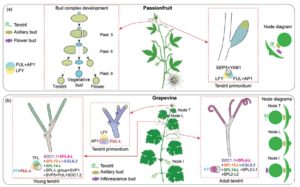 There are obvious advantages to being a climbing plant; for example, climbing is a low-cost way to avoid being shaded by your neighbors. Tendrils, which evolved independently several times, are one climbing strategy (others include twining stems and sticky adventitious roots). Sousa-Baena et al. review the development of tendrils in several plant families. Although tendrils can originate from diverse tissues including leaflets, stems and possibly reproductive structures, they share the trait of “helical growth during contact-induced coiling” which results from asymmetric contraction. However, the gene networks underlying tendril development are not generally shared, reinforcing the idea that these are convergent structures. As yet, the cytoskeletal components that may contribute to tendril coiling and further reveal its molecular basis have not been characterized in most tendril-producing families. (Summary by Mary Williams) New Phytol. 10.1111/nph.15073
There are obvious advantages to being a climbing plant; for example, climbing is a low-cost way to avoid being shaded by your neighbors. Tendrils, which evolved independently several times, are one climbing strategy (others include twining stems and sticky adventitious roots). Sousa-Baena et al. review the development of tendrils in several plant families. Although tendrils can originate from diverse tissues including leaflets, stems and possibly reproductive structures, they share the trait of “helical growth during contact-induced coiling” which results from asymmetric contraction. However, the gene networks underlying tendril development are not generally shared, reinforcing the idea that these are convergent structures. As yet, the cytoskeletal components that may contribute to tendril coiling and further reveal its molecular basis have not been characterized in most tendril-producing families. (Summary by Mary Williams) New Phytol. 10.1111/nph.15073
Initiation of meiotic recombination is regulated by epigenetic marks and chromatin structure
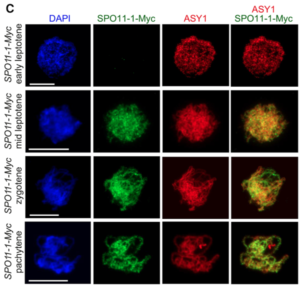 Meiotic recombination is an important source of genetic diversity by allowing the reshuffling of parental alleles during meiosis. It requires the generation of DNA double-strand breaks (DSBs) initiated by the activity of the SPO11 protein complex. In plants, the impact of chromatin structure and DNA methylation on the meiotic DSB landscape genome-wide remains unclear. In this study, the authors sequenced SPO11-oligonucleotides – short DNA sequences that are a by-product of SPO11 activity and indicative of the DSB location – to provide a high-resolution map of meiotic DSB in Arabidopsis thaliana. They show that meiotic DSBs hotspots preferentially occur in gene promoter and terminator nucleosome-free regions, but also in DNA transposons such as Helitrons and MuDR that show low nucleosome occupancy. Transposons are usually heavily transcriptionally silenced by epigenetic mechanisms such as DNA methylation. To investigate the effect of DNA methylation on the meiotic DSB landscape, the authors sequenced SPO11-oligos in the DNA methylation mutant met1. Remarkably, they observed an increase in meiotic DSB hotspots at pericentromeric transposons compared to wild-type, associated with a reduction in nucleosomal occupancy and activation of transcription. Altogether, this study provides new insights in the interplay between chromatin structure, genes and transposons in the regulation of meiotic DSBs, with important consequences on genetic diversity and genome evolution. (Summary by Matthias Benoit) Genome Research 10.1101/gr.225599.117
Meiotic recombination is an important source of genetic diversity by allowing the reshuffling of parental alleles during meiosis. It requires the generation of DNA double-strand breaks (DSBs) initiated by the activity of the SPO11 protein complex. In plants, the impact of chromatin structure and DNA methylation on the meiotic DSB landscape genome-wide remains unclear. In this study, the authors sequenced SPO11-oligonucleotides – short DNA sequences that are a by-product of SPO11 activity and indicative of the DSB location – to provide a high-resolution map of meiotic DSB in Arabidopsis thaliana. They show that meiotic DSBs hotspots preferentially occur in gene promoter and terminator nucleosome-free regions, but also in DNA transposons such as Helitrons and MuDR that show low nucleosome occupancy. Transposons are usually heavily transcriptionally silenced by epigenetic mechanisms such as DNA methylation. To investigate the effect of DNA methylation on the meiotic DSB landscape, the authors sequenced SPO11-oligos in the DNA methylation mutant met1. Remarkably, they observed an increase in meiotic DSB hotspots at pericentromeric transposons compared to wild-type, associated with a reduction in nucleosomal occupancy and activation of transcription. Altogether, this study provides new insights in the interplay between chromatin structure, genes and transposons in the regulation of meiotic DSBs, with important consequences on genetic diversity and genome evolution. (Summary by Matthias Benoit) Genome Research 10.1101/gr.225599.117
Dysregulation of expression correlates with rare-allele burden and fitness loss in maize ($)
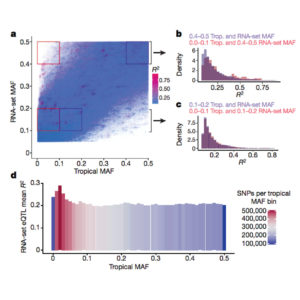 Deleterious mutations often underlie disease susceptibility and reduced fitness, but are very difficult to study due to their low frequency in the population. Maize is a great system for studying deleterious mutations because of high genetic diversity and the rapid decay in genetic linkage, enabling high resolution mapping of rare and common alleles. Kremling and colleagues studied the transcriptome of seven different tissues across 255 maize varieties, identifying a relationship between the abundance of rare alleles in the upstream gene coding region and extreme gene expression. The rare variants closest to the transcription start site had the largest effect on gene expression. The rare alleles of tropical maize population explained more variation in expression than common alleles. Interestingly, those rare alleles a have higher frequency in temperate maize varieties. This suggests that the tropical-to-temperate bottleneck is responsible for substantial changes in gene expression. Using previously collected data on plant fitness, the team identified that rare allele burden correlated with decreased fitness, yet the effect is still to be confirmed using bi-parental populations. This study provides first link between deleterious mutations affecting gene expression, altered allele frequencies caused by population bottlenecks, and fitness consequences. (Summary by Magdalena Julkowska) Nature 10.1038/nature25966
Deleterious mutations often underlie disease susceptibility and reduced fitness, but are very difficult to study due to their low frequency in the population. Maize is a great system for studying deleterious mutations because of high genetic diversity and the rapid decay in genetic linkage, enabling high resolution mapping of rare and common alleles. Kremling and colleagues studied the transcriptome of seven different tissues across 255 maize varieties, identifying a relationship between the abundance of rare alleles in the upstream gene coding region and extreme gene expression. The rare variants closest to the transcription start site had the largest effect on gene expression. The rare alleles of tropical maize population explained more variation in expression than common alleles. Interestingly, those rare alleles a have higher frequency in temperate maize varieties. This suggests that the tropical-to-temperate bottleneck is responsible for substantial changes in gene expression. Using previously collected data on plant fitness, the team identified that rare allele burden correlated with decreased fitness, yet the effect is still to be confirmed using bi-parental populations. This study provides first link between deleterious mutations affecting gene expression, altered allele frequencies caused by population bottlenecks, and fitness consequences. (Summary by Magdalena Julkowska) Nature 10.1038/nature25966
Metal sensing by the IRT1 transporter-receptor
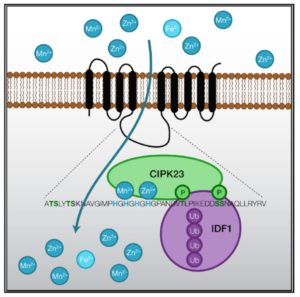 Plants need some but not too much iron, so the regulation of iron transporters is quite tight. IRT1 is a broad-spectrum metal transporter that is crucial for iron uptake (mutants can only be rescued by massive amounts of iron). IRT1 synthesis is transcriptionally upregulated by iron limitation, and although it is turned over by endocytosis, this turnover appears to be independent of iron levels. Dubeaux et al. showed that endocytosis and degradation of IRT1 is instead controlled by high levels of non-iron metals, such as manganese, cobalt and zinc. They further showed that the levels of non-iron metals are sensed directly by the IRT1 protein, through a stretch of histidine residues. Therefore, IRT1 serves as both a metal transporter and a receptor: a transcepter. (Summary by Mary Williams) Mol. Cell 10.1016/j.molcel.2018.02.009
Plants need some but not too much iron, so the regulation of iron transporters is quite tight. IRT1 is a broad-spectrum metal transporter that is crucial for iron uptake (mutants can only be rescued by massive amounts of iron). IRT1 synthesis is transcriptionally upregulated by iron limitation, and although it is turned over by endocytosis, this turnover appears to be independent of iron levels. Dubeaux et al. showed that endocytosis and degradation of IRT1 is instead controlled by high levels of non-iron metals, such as manganese, cobalt and zinc. They further showed that the levels of non-iron metals are sensed directly by the IRT1 protein, through a stretch of histidine residues. Therefore, IRT1 serves as both a metal transporter and a receptor: a transcepter. (Summary by Mary Williams) Mol. Cell 10.1016/j.molcel.2018.02.009
Tip-localized Ca2+-permeable channels control pollen tube growth via kinase-dependent R- and S-type anion channel regulation
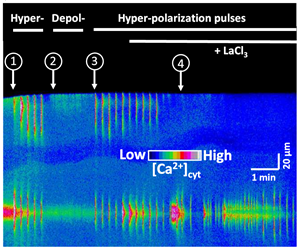 Calcium plays a major role in regulating pollen tube (PT) growth. Calcium levels are oscillatory in nature at the PT tip, along with anion efflux. Calcium has been shown to regulate anion channels in guard cells through calcium protein kinase (CPK) activation. Gutermuth et al. provide evidence for a similar mechanism in PTs. They developed a novel protocol for time-controlled stimulation of calcium entry at PT tips via electrophysiological induction of hyperpolarization pulses. This allows for calcium to enter PTs in a spatially and temporally controlled manner. By this method, calcium entry was sufficient to activate anion channels, confirmed by adding an anion channel inhibitor in tandem with the hyperpolarization-triggered calcium transients which blocked anion channel activity. Loss of various CPKs also resulted in loss of anion channel activity, regardless of this hyperpolarization-triggered calcium increase. Furthermore, loss of CPKs and/or anion channel activity impairs growth of PTs. These data support a model in which calcium induces CPK-dependent anion channel activation necessary for PT growth. (Summary by Alecia Biel) New Phytol. 10.1111/nph.15067.
Calcium plays a major role in regulating pollen tube (PT) growth. Calcium levels are oscillatory in nature at the PT tip, along with anion efflux. Calcium has been shown to regulate anion channels in guard cells through calcium protein kinase (CPK) activation. Gutermuth et al. provide evidence for a similar mechanism in PTs. They developed a novel protocol for time-controlled stimulation of calcium entry at PT tips via electrophysiological induction of hyperpolarization pulses. This allows for calcium to enter PTs in a spatially and temporally controlled manner. By this method, calcium entry was sufficient to activate anion channels, confirmed by adding an anion channel inhibitor in tandem with the hyperpolarization-triggered calcium transients which blocked anion channel activity. Loss of various CPKs also resulted in loss of anion channel activity, regardless of this hyperpolarization-triggered calcium increase. Furthermore, loss of CPKs and/or anion channel activity impairs growth of PTs. These data support a model in which calcium induces CPK-dependent anion channel activation necessary for PT growth. (Summary by Alecia Biel) New Phytol. 10.1111/nph.15067.
Mechanistic basis for the activation of membrane receptor kinases by SERK-family coreceptors
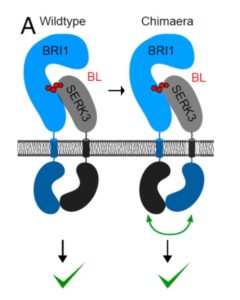 LRR-RKs (Leucine-Rich Repeat Receptor Kinases) are membrane-spanning receptor molecules that recognize a diverse array of signaling ligands. SERKs (SOMATIC EMBRYOGENESIS RECEPTOR KINASEs) are co-receptors that are required for signal processing. Like LRR-RKs, SERKs span the membrane, with an intracellular kinase domain and an external LRR ectodomain, but the SERK ectodomain is smaller than that of LRR-RKs. Hohmann et al. explored the interaction between the ligands and the LRR-RK – SERK co-receptor pair. They found that there are two distinct interaction sites in the ectodomains and that these domains differently affect ligand sensing, complex formation,
LRR-RKs (Leucine-Rich Repeat Receptor Kinases) are membrane-spanning receptor molecules that recognize a diverse array of signaling ligands. SERKs (SOMATIC EMBRYOGENESIS RECEPTOR KINASEs) are co-receptors that are required for signal processing. Like LRR-RKs, SERKs span the membrane, with an intracellular kinase domain and an external LRR ectodomain, but the SERK ectodomain is smaller than that of LRR-RKs. Hohmann et al. explored the interaction between the ligands and the LRR-RK – SERK co-receptor pair. They found that there are two distinct interaction sites in the ectodomains and that these domains differently affect ligand sensing, complex formation,
and complex stability. One key finding is the suggestion that the main function of the SERK co-receptor may be to slow the dissociation of the ligand from the LRR-RK protein. The authors further speculate that SERKs may have evolved “as adapter proteins that allow LRR-RKs to transduce information across membranes without the need for major conformation rearrangements“. (Summary by Mary Williams) PNAS
Diffusible repression of cytokinin signaling produces endodermal symmetry and passage cells
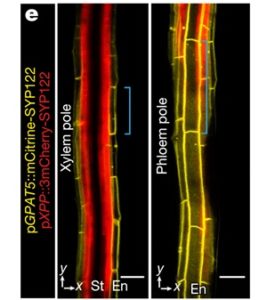 Passage cells are a subset of interspersed root endodermal cells that are unsuberized, which is thought to aid in transport because suberin inhibits transcellular transport. In Arabidopsis, suberization follows a stereotypic pattern which responds to many stress conditions, partly mediated by abscisic acid (ABA). Anderson et al. investigate the mechanism behind this patterning and the role suberin plays in transport of nutrients into the root. Suberin-lacking cells associated with the xylem pole and two xylem patterning mutants, cytokinin-related, displayed reduced numbers of passage cells. Cytokinin was mostly absent in unsuberized cells, and exogenous cytokinin application decreased passage cell numbers, as did ABA. On the other hand, cytokinin inhibition resulted in mostly passage-like endodermal cells that lacked suberization and this was not rescued by addition of ABA. Lastly, they identified passage cell-specific expression of transporters involved in nutrient uptake. This work expands upon the role and regulation of suberin in the endodermis as well as adding to the current model of nutrient uptake in plants. (Summary by Alecia Biel) Nature. 10.1038/nature25976.
Passage cells are a subset of interspersed root endodermal cells that are unsuberized, which is thought to aid in transport because suberin inhibits transcellular transport. In Arabidopsis, suberization follows a stereotypic pattern which responds to many stress conditions, partly mediated by abscisic acid (ABA). Anderson et al. investigate the mechanism behind this patterning and the role suberin plays in transport of nutrients into the root. Suberin-lacking cells associated with the xylem pole and two xylem patterning mutants, cytokinin-related, displayed reduced numbers of passage cells. Cytokinin was mostly absent in unsuberized cells, and exogenous cytokinin application decreased passage cell numbers, as did ABA. On the other hand, cytokinin inhibition resulted in mostly passage-like endodermal cells that lacked suberization and this was not rescued by addition of ABA. Lastly, they identified passage cell-specific expression of transporters involved in nutrient uptake. This work expands upon the role and regulation of suberin in the endodermis as well as adding to the current model of nutrient uptake in plants. (Summary by Alecia Biel) Nature. 10.1038/nature25976.
Photoperiodic control of seasonal growth is mediated by ABA acting on cell-cell communication ($)
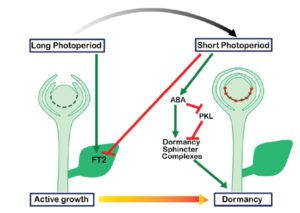 Plant growth is regulated seasonally, but our knowledge is limited about how their growth is inhibited or re-initiated seasonally. Looking at hybrid aspen, in this article, Tylewicz et al. explored how seasonal cycles of growth and dormancy help perennial plants adapt during winter. In the long days of summer, FT1 (FLOWERING LOCUS T 1) is expressed and moves between cells to the shoot meristem and promotes growth. In winter, short photoperiods suppress FT1 expression. Furthermore, there is an increase in the level of ABA and its response. Due to the change in ABA response, callosic dormancy sphincters form, which cause plasmodesmata to close, interfering with cell-to-cell communication and FT1 transfer to the meristem. Interestingly, overexpression of PDLP1 (PLASMODESMATA-LOCATED PROTEIN 1) is sufficient to block the release of bud dormancy after transfer to long photoperiods, without changing the ABA response. Taken together, the model suggests that shorter photoperiods alter ABA response and plasmodesmata closure, which prevents precocious growth during the period of dormancy. (Summary by Arif Ashraf) Science: 10.1126/science.aan8576
Plant growth is regulated seasonally, but our knowledge is limited about how their growth is inhibited or re-initiated seasonally. Looking at hybrid aspen, in this article, Tylewicz et al. explored how seasonal cycles of growth and dormancy help perennial plants adapt during winter. In the long days of summer, FT1 (FLOWERING LOCUS T 1) is expressed and moves between cells to the shoot meristem and promotes growth. In winter, short photoperiods suppress FT1 expression. Furthermore, there is an increase in the level of ABA and its response. Due to the change in ABA response, callosic dormancy sphincters form, which cause plasmodesmata to close, interfering with cell-to-cell communication and FT1 transfer to the meristem. Interestingly, overexpression of PDLP1 (PLASMODESMATA-LOCATED PROTEIN 1) is sufficient to block the release of bud dormancy after transfer to long photoperiods, without changing the ABA response. Taken together, the model suggests that shorter photoperiods alter ABA response and plasmodesmata closure, which prevents precocious growth during the period of dormancy. (Summary by Arif Ashraf) Science: 10.1126/science.aan8576
AUXIN RESPONSE FACTOR3 regulates floral meristem determinacy by repressing cytokinin biosynthesis and signaling ($)
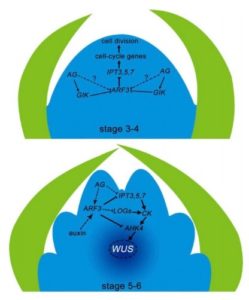 The cross-talk between cytokinin and auxin has been well established from different developmental perspective. In this article, Zhang et al. have explored the role of cytokinin and auxin cross-talk in floral meristem (FM) determinacy. The authors demonstrated that auxin induces the expression of ARF3 (AUXIN RESPONSE FACTOR3) and ARF3 regulates both cytokinin biosynthesis and signaling. ARF3 represses the cytokinin biosynthesis genes IPT (ISOPENTENYL TRANSFERASE) and LOG (LONELY GUY); and signaling components AHK4 (ARABIDOPSIS HISTIDINE KINASE 4). In addition, AGAMOUS (AG) controls the expression of ARF3 and IPTs to regulate FM maintenance and termination via cell division. This work has established the role of ARF3, which acts synergistically with AG to regulate cytokinin biosynthesis and signaling for FM maintenance and determinacy. (Summary by Arif Ashraf) Plant Cell: 10.1105/tpc.17.00705
The cross-talk between cytokinin and auxin has been well established from different developmental perspective. In this article, Zhang et al. have explored the role of cytokinin and auxin cross-talk in floral meristem (FM) determinacy. The authors demonstrated that auxin induces the expression of ARF3 (AUXIN RESPONSE FACTOR3) and ARF3 regulates both cytokinin biosynthesis and signaling. ARF3 represses the cytokinin biosynthesis genes IPT (ISOPENTENYL TRANSFERASE) and LOG (LONELY GUY); and signaling components AHK4 (ARABIDOPSIS HISTIDINE KINASE 4). In addition, AGAMOUS (AG) controls the expression of ARF3 and IPTs to regulate FM maintenance and termination via cell division. This work has established the role of ARF3, which acts synergistically with AG to regulate cytokinin biosynthesis and signaling for FM maintenance and determinacy. (Summary by Arif Ashraf) Plant Cell: 10.1105/tpc.17.00705



